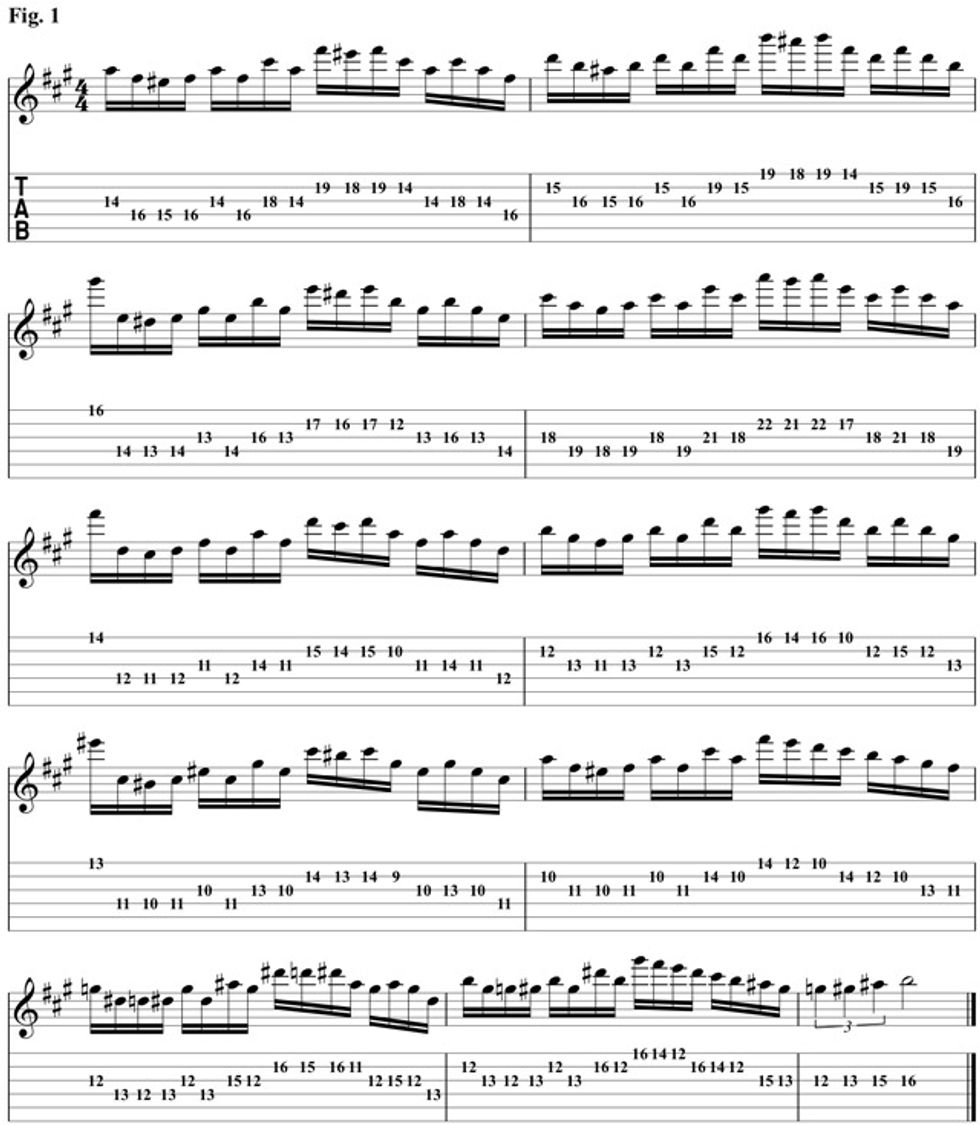Chops: Intermediate
Theory: Intermediate
Lesson Overview:
• Learn the correct way to steal
from the classical masters.
• Understand the “real” way to
play “Scarified.”
• Create long, flowing baroque-inspired
lines using “outside”
picking.
The biggest hit I’ve ever had a part in is the Mr. Big single, “To Be with You.” It went to No. 1 on the charts all over the world, and I continue to brag about it whenever I have to write a bio for myself. I do feel that I did a solid and respectable job of strumming the chords, singing some harmonies, and playing a theme-reinforcing guitar solo, but I did not, I repeat, I did not write the song. I wish I had. It’s a great tune. But I have to give credit and gratitude to Mr. Big’s vocalist, Eric Martin, for making that happen. Thank you, Eric!
When it comes to hits, I have not had many outside of Mr. Big. Certainly nothing that has climbed the charts and sat next to Mariah Carey and Right Said Fred. But among the people who like to listen to guitar music, I’ve had the good fortune to have penned a couple of ... let’s call them “favorites.” The Racer X song “Scarified” would be one of those. And if my math is correct, the song is 25 years old now. Happy birthday to it!
“Scarified” began its life as a furious and deadly accurate double-bass drum riff by Scott Travis. I heard him playing it in rehearsal and did my best to attach some notes to his rhythms. That gave us the instrumental equivalent of a verse, but to complete the song, we needed more.
At the time, I was enamored with the fact that classical music of a certain age was legally considered “public domain” and could be plundered with wild abandon. Bach, Mozart, Beethoven. All that creative genius was (and still is) available to any writer who cared to borrow or steal from it, for the same price as a breath of air.
So steal I did. Or at least tried to. I was listening to my favorite harpsichord concerto (credited to J.C. Bach) and I began to learn my favorite sections of it by ear. This wasn’t easy! The notes were quick 16ths, and they were sometimes buried while competing with the accompanying orchestra for space in the mix. Also, these phrases had never been played on guitar before. Licks that might be a breeze on a harpsichord can be distinctly challenging when translated to another instrument. But I did my best, and came up with something that worked for the next section of the song. The result was a classical/ metal onslaught that became an immediate crowd-pleaser at our live shows and still rewards me with millions of YouTube hits from my solo version of the tune.
But one thing always bothered me about stealing these classical licks. And that is that I didn’t steal them correctly. So, after much creative hunting, I finally managed to locate the sheet music of the original harpsichord concerto. This was back in 1998, and I was feeling so ambitious I actually recorded the entire first movement of the concerto, using guitars to cover not only the harpsichord parts, but also the violins, violas, cellos, and string bass parts. I named my recording “Gilberto Concerto,” and after completing the recording, I promptly forgot all the parts due to the impossibility of remembering that many notes.
Fast forward to the present, and I found myself preparing for a gig and looking at “Scarified” in the middle of my set list. I thought it might be nice to finally take the correct notes that I briefly learned in 1998, and practice them until I could actually perform them live. So I dusted off the score, asked my wife—who sight-reads much better than I do—to play the notes slowly on the piano. I recorded her playing so I could easily learn the notes by ear (without having to battle fast tempos or competing orchestras). After a couple of weeks, I had it, and now I give it to you in Fig. 1.

The key to making this playable is the fingerings. Some fingerings make the lefthand part easier. Some fingerings make the picking easier. Some fingerings make the shapes easier to remember. Some fingerings make the notes easier to keep clean without string noise. I’m pretty sure I tried every possibility and every combination. After much practicing and tweaking, I finally had a fingering that my brain could see, my fingers could navigate, and my ears approved of.
And live … I nailed it. Proof that it works!
A couple notes about technique. I did not include specific markings to show where I am picking and where I am using hammer-ons and pull-offs. If I included that much notation, the end result would be cumbersome and counter-productive. The general hints that I’ll give you are these: I am not picking everything. Whenever I switch from one string to the next, I will always pick that transition— with outside picking, if possible. (With outside picking, your flatpick comes across a string from its outer edge. For example, if I was playing two notes on the 3rd and 2nd strings, I’d strike them with a down-up move. This means after plucking the 3rd string, I’d sail over the 2nd string and then hit it with an upstroke. For an in-depth explanation, see my “How to Practice Pole- Vaulting” column in the June 2011 issue.)
But otherwise, I am using hammer-ons and pull-offs as often as I can. I have covered this “juggling” of techniques in previous columns, so I encourage you to look back and practice some of my simpler exercises to build this technique into a habit.
Finally, I would like to thank J.C. Bach, his famous dad, J.S. Bach, and all those amazing writers 250 years ago who may not be getting royalties on their tunes, but who continue to shake the air with the awesome music they wrote. They were so good that I am terrified—in fact, scarified.











![Rig Rundown: Russian Circles’ Mike Sullivan [2025]](https://www.premierguitar.com/media-library/youtube.jpg?id=62303631&width=1245&height=700&quality=70&coordinates=0%2C0%2C0%2C0)






